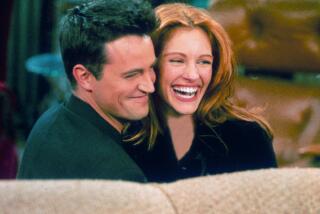PERSPECTIVE ON CELEBRITY : The Day--and Night--of the Locust : The crowds cheering O.J. Simpson were out of the Hollywood classic about stars being devoured to fill empty lives.
Watching the nationally televised spectacle from the Los Angeles freeways and Brentwood Friday evening was less exciting for me than it seems to have been for many others. It was, in fact, something of a disappointment. It’s usually that way when one has read the book before seeing the movie.
Although Nathanael West wrote it nearly 60 years ago, “The Day of the Locust” plainly is about the events we witnessed on Friday evening. Indeed, the similarities are so great that the telecast should have been called “The Night of the Locust.” For one thing, both the novel and the “real” drama feature important characters named Simpson. But West’s Homer Simpson is more like his cartoon namesake than like O.J. Simpson. The roles played by the two Simpsons are different, too; both are sad figures, but the original Homer Simpson was never a celebrity. He was, in fact, an anti-celebrity--one of the prototypes for the people who composed the crowds of cheering onlookers in last Friday’s production.
It was those crowds of spectators that gave anyone familiar with “The Day of the Locust” an eerie feeling of deja vu. It almost seemed that the chilling climax of the book was about to be re-enacted.
Throughout West’s novel, the protagonist, Tod Hackett, is working on a painting he calls “The Burning of Los Angeles.” It depicts what happens when people who can find no meaning in their lives migrate to California, but “once there, they discover that sunshine isn’t enough.” How could West’s characterization of the crowds in the painting and their coming to life in a wild mob outside a movie premiere not be about the crowds last Friday? “No longer bored, they sang and danced joyously in the red light of the flames,” West wrote. The flames last week were the figurative ones consuming the lives of O.J. Simpson, his former wife Nicole Brown Simpson and Ronald Goldman. Their immolation mattered not to the revelers. Something was happening. And it was being televised. Being on TV--the ultimate in artificiality--validates the lives of people trying to live without meaning.
It is apparent that modern Americans have difficulty distinguishing between fiction and reality. Several of West’s characters, like most of the people who came out for the production last Friday, suffer from this problem. One, Harry Greener, finds himself wondering whether he is acting or is actually ill.
The reality that West’s art reflected in the 1930s has grown far worse in the decades since. What he perceived--the emptiness and meaninglessness and alienation of modern life for so many people--was reflected in the multitude of bystanders professing love for O.J. as if they were not strangers to him.
Belonging to a community of personally known people is an essential part of human nature. This innate need is not satisfied for large numbers of people in our highly mobile society. The pursuit of dreams is individual, and separateness is incompatible with our natures as social beings.
Disconnected modern people are, like West’s Homer Simpson and the people Tod Hackett wanted to paint, half dead. Their hunger for a sense of being and personal connection remaining unfulfilled, they seek excitement in order to feel alive. But, as Paul Revere and the Raiders sang in the 1960s, “kicks just keep gettin’ harder to find.”
Identification with celebrities can provide some of the desired excitement, but is ultimately disappointing. As West put it, “At the sight of their heroes and heroines, the crowd would turn demoniac.” Modern disconnected people, he observed, need ever more to feel alive: “cultists of all sorts, economic as well as religious . . . all those poor devils who can only be stirred by the promise of miracles and then only to violence.” Yet, West perceptively noted, “nothing can ever be violent enough to make taut their slack minds and bodies. They have been cheated and betrayed. They have slaved and saved for nothing.”
Many observers across the country who were disturbed by what they saw last Friday have tried to reassure themselves by asserting that this was one of those “only in California” phenomena. They are wrong, as Nathanael West well understood. The crowds that Tod Hackett was portraying in “The Burning of Los Angeles” were “the cream of America’s madmen,” West wrote, and Tod “felt almost certain that the milk from which it had been skimmed was just as rich in violence. The Angelenos would be first, but their comrades all over the country would follow.”
What we saw in “The Night of the Locust” that so unnerved us was “The Burning of Los Angeles II: The Burning of America.” The video screens on which we saw this Tod Hackett canvas were mirrors in which we saw ourselves. It was not a comforting reflection.
More to Read
The biggest entertainment stories
Get our big stories about Hollywood, film, television, music, arts, culture and more right in your inbox as soon as they publish.
You may occasionally receive promotional content from the Los Angeles Times.










